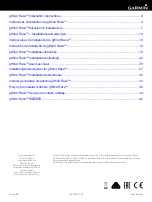
Specialized Modem Operation
Modems designed to achieve the highest data rates possible in a radio channel may require a
direct DC connection to the modulation path and the removal of the limiter-filter. In order to
receive FCC Certification, the DTX module must either be tested and approved with a specific
modem connected to the transmitter, or a modulation limiter and limiter-filter must always be
present in the transmit modulator audio path with the modulation inputs AC coupled. To allow for
the most flexibility for the end user, the unit was certified as a stand-alone unit. It is possible, with
hardware modifications and special programming software (not supplied with the unit), to DC
couple the AUX IN input and/or defeat the limiter-filter. The modulation limiter would still be in
place, but the deviation of the DTX module could be set such that the modulation limit within the
DTX module is never reached. The deviation would be set by the modem level and the AUX IN
gain setting. The end user/system integrator would then bear the responsibility of obtaining
certification or operating in a frequency band where certification is not required. Contact RITRON
for details.
Note: Most modems will connect directly to the DTX without requiring any
special modifications or programming.
Antenna Placement
The DTX module is enclosed in a metal housing for RF shielding. However, RF emitting sources
located very close (less than 12 inches) to the unit can at times affect its operation. It is not
recommended that an antenna be connected directly to the module’s BNC connector unless the
RF output power is set for less than 5 watts or the module is placed within another RF-tight
enclosure.
5.6
RNET COMPATIBILITY MODE
The DTX module can be programmed to mimic some of the behavior of the RNet 450 radio. In
the RNet compatibility mode, the CSN input is used as a channel selector line. A logic low
selects channel 1 while a logic high selects channel 2. The channel select lines, CS0, CS1, and
CS2 have no effect. Also, the DCD output is held in its true state during transmit. It would
normally be false in transmit.
5.7
RECEIVER SELF-QUIETING SPUR (BIRDIE) FREQUENCIES
Receiver self-quieting spurious signals (birdies) are internally generated signals that result from
the outputs and harmonics of the outputs of the various oscillators that form part of the DTX
radio. These usually sound like unmodulated carriers -- signals with "dead air." The DTX has
two oscillators that tend to cause birdies, the 14.4 MHz reference oscillator and the 12.288 MHz
oscillator on the control/loader board. Of these two, the 14.4 MHz is by far the most significant
due to its proximity to the sensitive receiver circuitry. Most of the spur frequencies in the following
table have sensitivity degraded by 3 dB or less. Frequencies where the sensitivity is degraded
more than 4 dB below specification are in
bold
. Frequencies that are integer multiples of the 14.4
MHz reference oscillator typically cause a reduction in sensitivity of 10 dB or more and are in
bold
and in
red
. Note that a birdie is not the same thing as a receiver spurious response. A
spurious response is the receiver hearing a signal on a frequency other than that to which it has
been programmed.
Self-Quieting Frequencies(MHz)














































